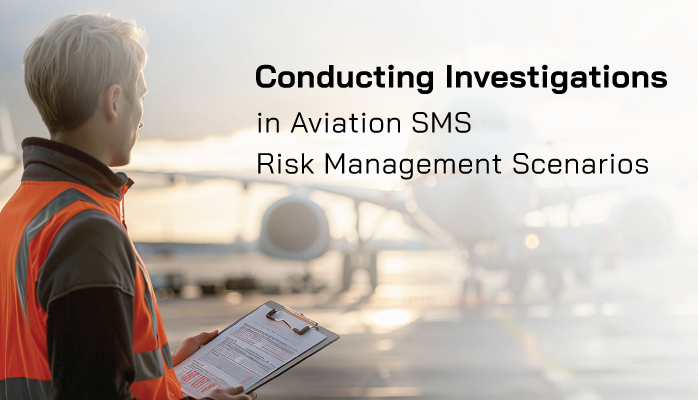Importance of Investigations in Aviation Risk Management

Investigations are the cornerstone of quality assurance efforts in aviation safety management systems (SMS). They are an attempt to answer why and how safety events occur. Investigations also commonly occur in response to reactive and proactive risk management activities after safety issues are submitted through the SMS' safety reporting system.
Different organizations use the term investigation differently depending on the context of the investigatory activity and common risk management practices within the organization.
Related Aviation Risk Management Articles
- Difference Between Reactive, Predictive and Proactive Risk Management in Aviation SMS
- What Are Important Factors of Aviation Risk Management Process
- 4 Critical Elements of the Aviation SMS Risk Management Process
Various Types of Risk Management Investigations
There are different types of investigations that aviation service providers use during their risk management activities, including:
- Performing routine and ad-hoc safety inspections to identify safety issues;
- Evaluating reported safety issues to determine damage, root cause, and operational risk;
- Evaluating whether safety issues were managed effectively to reduce risk to as low as reasonably practical (ALARP);
- Performing root cause analysis in both reactive and proactive risk management processes; and
- Evaluating safety performance of the aviation SMS implementation.
Regardless of what your company means when it says “investigation,” the reality is that your organization should perform all of these types of investigations. Here’s an overview of these investigations in aviation SMS.
How to Perform Safety Inspections in Safety Management Systems
Safety inspections in aviation SMS can be either a formal or informal type of investigation used to:
- Identify safety issues before they are reported (proactively); and
- Understand how closely operational practices match system documentation.
Safety inspections are best performed using an inspection checklist. Aviation compliance authorities generally provide many different types of inspection checklists. That being said, your organization should also develop custom inspection checklists that match the unique processes of your safety management system.
The subtle implication here is that inspections are used to investigate very specific aspects of your SMS, such as a single task, operation, or process. This is contrasted to aviation SMS audits, which are used to evaluate large aspects of your SMS, such as a system or division.
Safety inspections (and audits) may be performed either on operations under the company's direct control or operations contracted out by third parties, such as:
- Fuel providers;
- Cabin cleaning crews;
- Groundside security providers;
- Aircraft maintenance organization;
- Ground handling operations.
Related Articles on Audits and Inspections in Aviation SMS
- Real Difference Between an Aviation Safety Audit vs. Inspection
- How to Conduct Internal SMS Audits in Aviation Industry
- How to Create an Aviation SMS Audit Plan
How to Investigate Safety Issues in Aviation Risk Management Activities
Investigating safety issues is a process that safety managers and subject matter experts undertake on a daily basis every time safety hazards are identified and stakeholders submit safety issues through the aviation SMS' safety reporting system. Investigating safety issues includes the following goals, and perhaps additional goals depending on the context of the reported safety issue:
- Identify the extent of damage suffered to personnel, facilities, equipment, and reputation;
- Evaluate the likelihood of future recurrence;
- Evaluate the severity of consequences of current and potential future events;
- Understand the narrative and flow of events of the manifested safety event;
- Identify root causes, hazards, risks, human factors, etc.;
- Evaluate the performance of controls that contributed/mitigated the issue;
- Determine the responsibility and effect of manifested hazard in relation to operational interfaces (third parties affecting operations); and
- Contextualize the issue in larger SMS trends, should they exist.
These investigatory goals are accomplished through numerous tasks involved in both reactive and proactive risk management processes.
How to Review Past Safety Issues

After issues have been processed through your aviation SMS's risk management processes, they should be reviewed (investigated) at a later date. These types of “validation” investigations have two primary goals:
- Ensure that the associated risk for the identified hazard remains within an acceptable level of safety; and
- Evaluate whether management’s treatment of the safety issue complied with the SMS's documented risk management processes.
Usually, these two goals go hand in hand. If the issue remains acceptable, usually management’s performance is satisfactory, though there are certainly exceptions. The most common finding that quality assurance teams find in immature aviation SMS implementations is safety issues not treated according to documented risk management processes.
Reviewing safety issues that have already been treated in your risk management pipeline involves the following steps:
- Evaluate risk controls relevant to the reported safety issues’ primary hazard;
- Evaluate the efficacy of corrective actions and preventive actions that were created to mitigate the risk;
- Assess the safety issue for an acceptable level of safety; and
- Determine whether safety issue requires further actions to reduce risk to ALARP:
- If it requires further action, is this on account of mismanagement or new factors not previously detected in the operational environment?
- If it was mismanaged, how could management have performed better?
It’s important to try and avoid hindsight bias when reviewing management’s actions. Be sure to review management’s decisions and actions within the context of what they knew at the time period and the limitations of actions that they could have taken.
Related Aviation Risk Management Articles
- How to Review Safety Issues in Aviation SMS
- 5 Tips Reviewing Hazards, Risks & Controls in Aviation SMS - With Examples
- How to Review Your Aviation Safety Risk Management Procedures
How to Perform Root Cause Analysis Investigations
Root cause analysis is an investigatory process with the following goals:
- Understand why the safety issue happened;
- Establish precursors to danger;
- Establish underlying causes for the manifestation of the safety event; and
- Develop strategies to prevent recurrence.
A common tendency is to not analyze in depth when conducting a root cause analysis. Too often, an investigator may hastily identify the more obvious root cause factor, but overlook a secondary or tertiary factor that contributed to the event. We present this to alert readers that just because you identified a singular root cause, there may be other factors lurking and these factors may be identified by continually asking: "Why did this event occur?"
Root cause analysis is performed on identified AND reported safety events that are active in the aviation SMS' reactive or proactive risk management process. The most common tools for root cause analysis are:
- Bowtie analysis;
- Fault tree analysis;
- 5-Whys analysis; and
- Fishbone diagrams.
Safety professionals will recognize that they have correctly identified the root cause as they return to monitoring the system. If there is a recurrence of the safety issue, then it becomes obvious the analysis was incorrect. Do you think this process is reliant too much on luck? Safety performance monitoring validates managers' assumptions.
See more: How to Conduct Root Cause Analysis in Aviation SMS
How to Review Safety Performance in Aviation SMS

A final, common type of investigation in aviation SMS is investigating the safety performance of the entire aviation SMS. You can evaluate safety performance via:
- Safety metrics/charts;
- Key performance indicators; and
- Leading indicators.
Using charts, KPIs, and other metrics to evaluate safety performance involves understanding various aspects of safety performance. The reality is that there is no one overall safety performance metric. For example, you may have different performance levels for:
- Aviation safety culture;
- Hazard mitigation; and
- SRM due diligence.
The categories you evaluate safety performance should be organized based on company goals. In other words, the performance of each company goal should be investigated. This type of investigation is typically conducted on a recurring basis, such as:
- Quarterly;
- Semi-annually; or
- Annually.
Reviewing company goals and objectives only once per year is not a recommended approach. There is not enough time to identify deficiencies and apply corrective actions when review periods are too far apart. We recommend quarterly reviews; however, the best approach is to have real-time, interactive dashboard charts that quickly alert management of substandard behaviors.
Related Aviation SMS Monitoring Articles
- 4 Pillars | How to Conduct Safety Performance Monitoring and Measurement
- How to Monitor and Control Risk in Aviation SMS
- 5 Useful Safety Performance Monitoring Tools in Aviation SMS
Final Thoughts on Investigations in Aviation SMS
When safety professionals consider the term "investigation," they may visualize a group of subject matter experts responding to an accident to determine "what went wrong." However, as we have seen, reacting to reported safety events is only part of the picture. Other circumstances in your daily SMS activities may prompt an investigation.
How do you view investigations in your aviation SMS?
Are your investigations always initiated due to reactive risk management activities?
What percentage of your investigations are reactive in nature? Proactive in nature?
I hope we have expanded your viewpoint of how and when to conduct investigations in your SMS. Investigations don't have to be burdensome or require inordinate amounts of time. The amount of time to devote to any particular investigation is dependent on:
- Context (type of event under consideration);
- Reactive or proactive risk management activity;
- Availability of tools (SMS database or spreadsheets);
- Availability of data (your SMS' data management strategy);
- Education level of safety professionals conducting investigation; and
- Amount of time.
From the above list, three factors can be noticeably affected by technology;
- availability of data,
- education; and
- time.
An aviation SMS database will definitely improve your safety team's effectiveness in conducting investigations by providing structure. An SMS database comes complete with risk management processes that easily capture and store related safety data. This in turn reduces the time normally spent documenting reactive and proactive risk management processes. The result? More time to conduct investigations that further reduce your risk exposure.
Do you have an SMS database to manage your SMS investigations? If not, SMS Pro can help.
Learn how you can manage your SMS more easily using an SMS database.
Last updated in April 2025.







